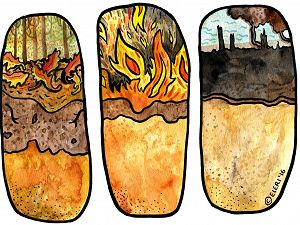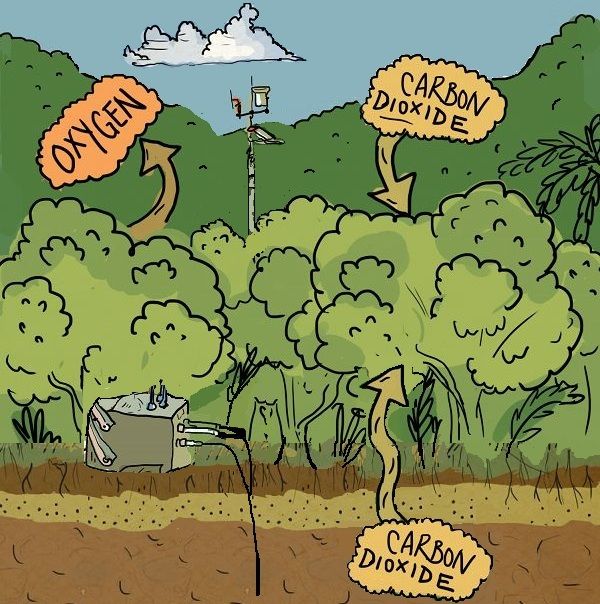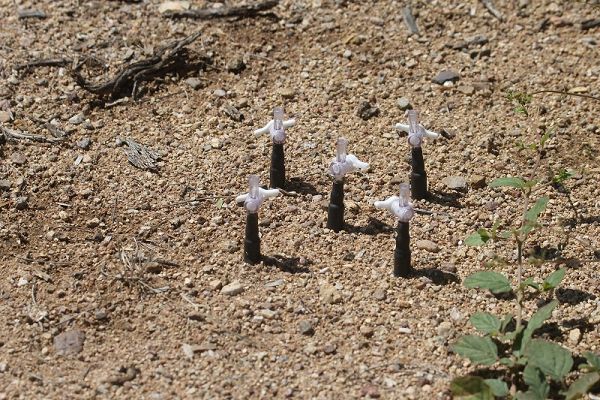Apr 14, 2017
Watching the clouds fly past on a sunny summer day is not just a pleasant scene, they also show how dynamic our atmosphere is. We can see the clouds being carried away by shifting winds, but we can’t see the invisible ocean of gases the clouds sit upon. It is unfortunate there is an invisible world of molecules before our eyes and we cannot see the rapid movement of gases such as carbon dioxide (CO2) and oxygen (O2). These unseen molecules are what keep the Critical Zone of the Earth habitable for plants, and animals, and us humans. Plants and animals all breathe in and release gases to maintain healthy concentrations of CO2) and oxygen O2 in our blood and cells. If we can’t observe gases flowing around us with our eyes, how can we see the Critical Zone breathe?
An illustration of the Critical Zone 'breathing' in carbon dioxide and releasing oxygen. Vegetation takes in carbon dioxide and releases oxygen. Soil plays a key role in the global carbon system releasing carbon dioxide as well.
One of the most fundamental way scientists learn about parts of the natural world is to weigh it to determine an objects mass before and after a chemical reaction or process has taken place. However, gases are difficult to weigh and determine their mass accurately. Weighing the mass of air using vacuums and other techniques has been a long standing question since Jean Rey and others in the early 1600s. Only since experiments in the 1700s by Henry Cavendish and others were scientists able to measure the mass of gases. If we know the density of a gas and the volume it occupies, we can compute the mass of a gas. The ideal gas law concept was revolutionary in how we relate temperature, pressure, and mass of a gas.
Nowadays, we measure gases in the atmosphere not by mass but quantifying its concentration in the air using indirect electronic sensors and probes. Many probes can measure CO2 and O2 by metal-gas reactions or using changes in light absorption using infrared and ultraviolet light sources. The exchange O2 and especially CO2 among plants, soils, and organisms are most of interest for Critical Zone scientists. The storage and release of CO2 from the Critical Zone is essential for understanding climate change.
Trees, shrubs, grasses, algae, and mosses ‘inhale’ or ‘fix’ CO2 during photosynthesis to create sugars using solar energy. Land plants fix roughly 120,000 teragrams of C during photosynthesis every year (Le Quéré et al 2015). That is roughly about 1 million Empire State Buildings of carbon dioxide is taken out of the atmosphere every year by plants! Bacteria, fungi, earthworms, deer, and humans ‘exhale’ or respire CO2 to breakdown carbon compounds we consume as food for energy. Even plants exhale CO2. Plants and animals on land exhale roughly 121,000 teragrams of C every year (Le Quéré et al 2015). Learn more about the global carbon cycle at University of New Hampshire’s resource: globecarboncycle.unh.edu/CarbonCycleBackground.pdf
Critical Zone scientists assess CO2 in many different ways. Scientists may attach mini-gas chambers to leaves to estimate the uptake of CO2 by a leaf. Scientists can collect soil gases using pumps or measure the release of CO2 from the surface of the soil using a gas chamber. Scientists can also calculate much bigger fluxes of CO2 from the Critical Zone to the atmosphere using a specialized instrumented tower, commonly called an eddy covariance tower or flux tower for short. These specialized towers are able to estimate the ‘inhale’ or ‘exhale’ of CO2 in the Critical Zone by estimating the difference in upward or downward movements CO2 (check out Baldocchi 2003 for additional background).
Scientists at the Santa Catalina-Jemez Mountains CZO are working to improve estimations of soil CO2 effluxes. To estimate the release of CO2 from soils, scientists frequently use portable chambers and measure the change in CO2 concentration into the chamber, but the sampling frequency is often low, normally weekly, monthly, or seasonally and often only during the daytime in fair weather conditions. Scientists have created an alternative to estimate better the soil CO2 effluxes continuously through time, using a combination of portable soil chamber measurements and the application of the gradient method technique, where soil CO2 is measured at multiple depths in the soil profile to estimate its movement and release from the surface.
In a study by Enrique Sánchez-Cañete and others at the Santa Catalina-Jemez Mountains CZO (2017), they found that most current models underestimated CO2 release from soil when applied to the gradient method. They conclude that future soil efflux studies need to use a combination of the gradient method and targeted manual or automatic chamber measurements to build a gas transfer model in situ and produce better long-term estimates CO2 from soils
By adding up changes in CO2 in leaves, soils, and the local atmosphere, we can see the Critical Zone breathing.
Have any questions swirling in your noodle about the rock, soil, water, fauna, or flora of the critical zone? Send them our way at Askcriticalzone@website.com.
Science on!
Justin Richardson
Critical Zone Observatory Post-Doctoral Fellow
References:
Baldocchi, D.D., 2003. Assessing the eddy covariance technique for evaluating carbon dioxide exchange rates of ecosystems: past, present and future. Global Change Biology, 9:479-492.
Le Quéré, C., Moriarty, R., Andrew, R.M., Peters, G.P., Ciais, P., Friedlingstein, P., Jones, S.D., Sitch, S., Tans, P., Arneth, A. and Boden, T.A., 2015. Global carbon budget 2014. Earth System Science Data, 7:47-85.
Sánchez-Cañete E.P., Scott R.L., van Haren J., and Barron-Gafford G.A. (2017): Improving the accuracy of the gradient method for determining soil carbon dioxide efflux. Journal of Geophysical Research: Biogeosciences 122:50-64.
DOI: 10.1002/2016JG003530
United States Environmental Protection Agency (USEPA) 2011. Inventory of U.S. greenhouse gas emissions and sinks: 1990–2009. EPA 430-R-11-005. https://www3.epa.gov/climatechange/Downloads/ghgemissions/US-GHG-Inventory-2011-Complete_Report.pdf .
An illustration of the Critical Zone 'breathing' in carbon dioxide and releasing oxygen. Vegetation takes in carbon dioxide and releases oxygen. Soil plays a key role in the global carbon system releasing carbon dioxide as well.
(Left) Picture of Enrique Sanchez-Cañete sampling soil carbon dioxide at the Catalina-Jemez CZO.
Picture of tubes used to sample carbon dioxide within the soil at the Catalina-Jemez CZO.

Justin B. Richardson
CZO INVESTIGATOR, STAFF. National Office outreach officer, Former CZO Post-Doctoral Fellow. Specialty: Soil biogeochemistry of plant-essential and toxic metals.
Biogeochemistry Soil Science / Pedology Outreach / Education Research EDUCATION/OUTREACH General Public K-12 Education
COMMENT ON "Adventures in the Critical Zone"
All comments are moderated. If you want to comment without logging in, select either the "Start/Join the discussion" box or a "Reply" link, then "Name", and finally, "I'd rather post as a guest" checkbox.
ABOUT THIS BLOG
Justin Richardson and his guests answer questions about the Critical Zone, synthesize CZ research, and meet folks working at the CZ observatories
YOU MAY LIKE

How do people manage carbon in soil?
Climate change. These two words illicit many feelings. Those in low lying areas dotted around the world’s oceans fear future sea level rising....
Justin Richardson

How does fire change a forest?
Article by Nicholas Dove (Southern Sierra CZO) and Justin Richardson (National Office) There is an idiom that states someone too involved in the...
Nicholas Dove

What is the Santa Catalina-Jemez River Basin Critical Zone Observatory?
An illlustrated introduction to the Santa Catalina-Jemez River Basin Critical Zone Observatory! By Justin Richardson and Jon Chorover....
Justin Richardson
General Disclaimer: Any opinions, findings, conclusions or recommendations presented in the above blog post are only those of the blog author and do not necessarily reflect the views of the U.S. CZO National Program or the National Science Foundation. For official information about NSF, visit www.nsf.gov.
Explore Further





